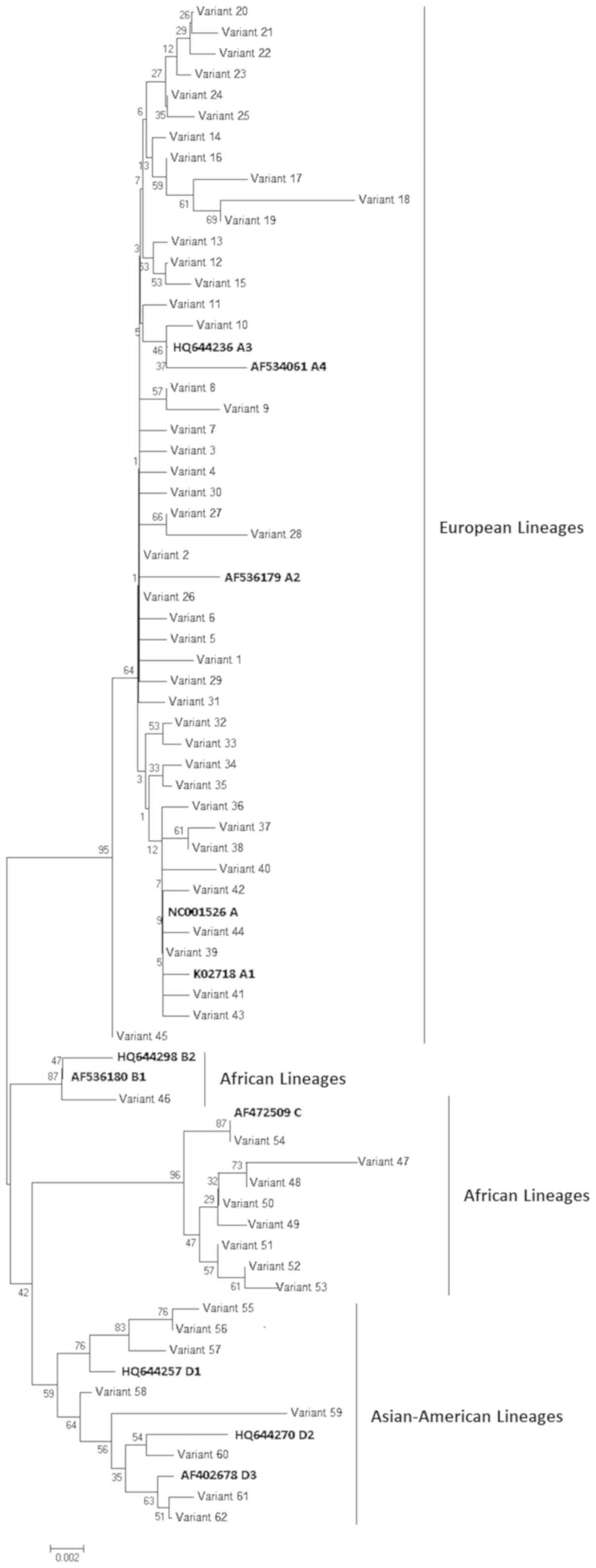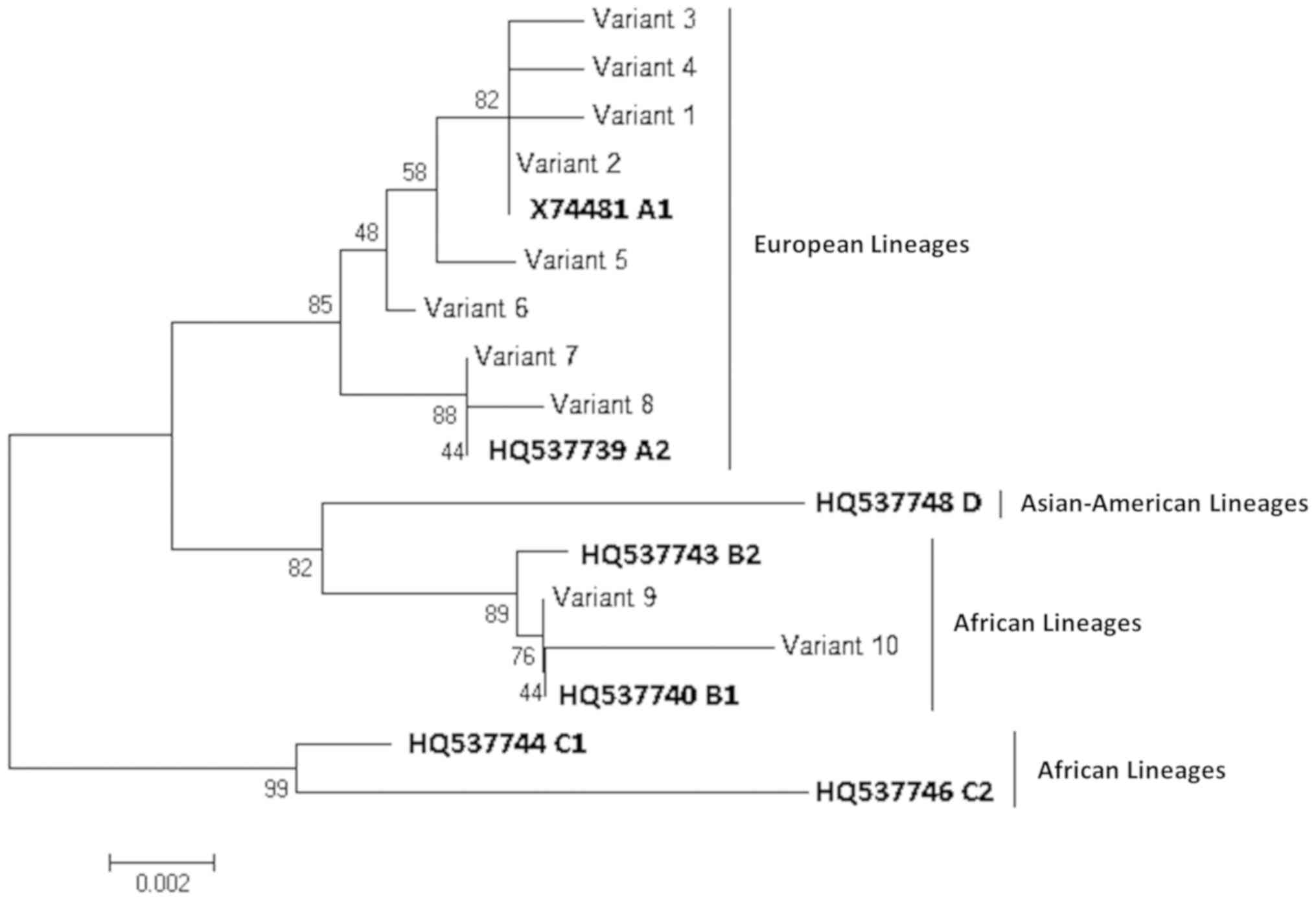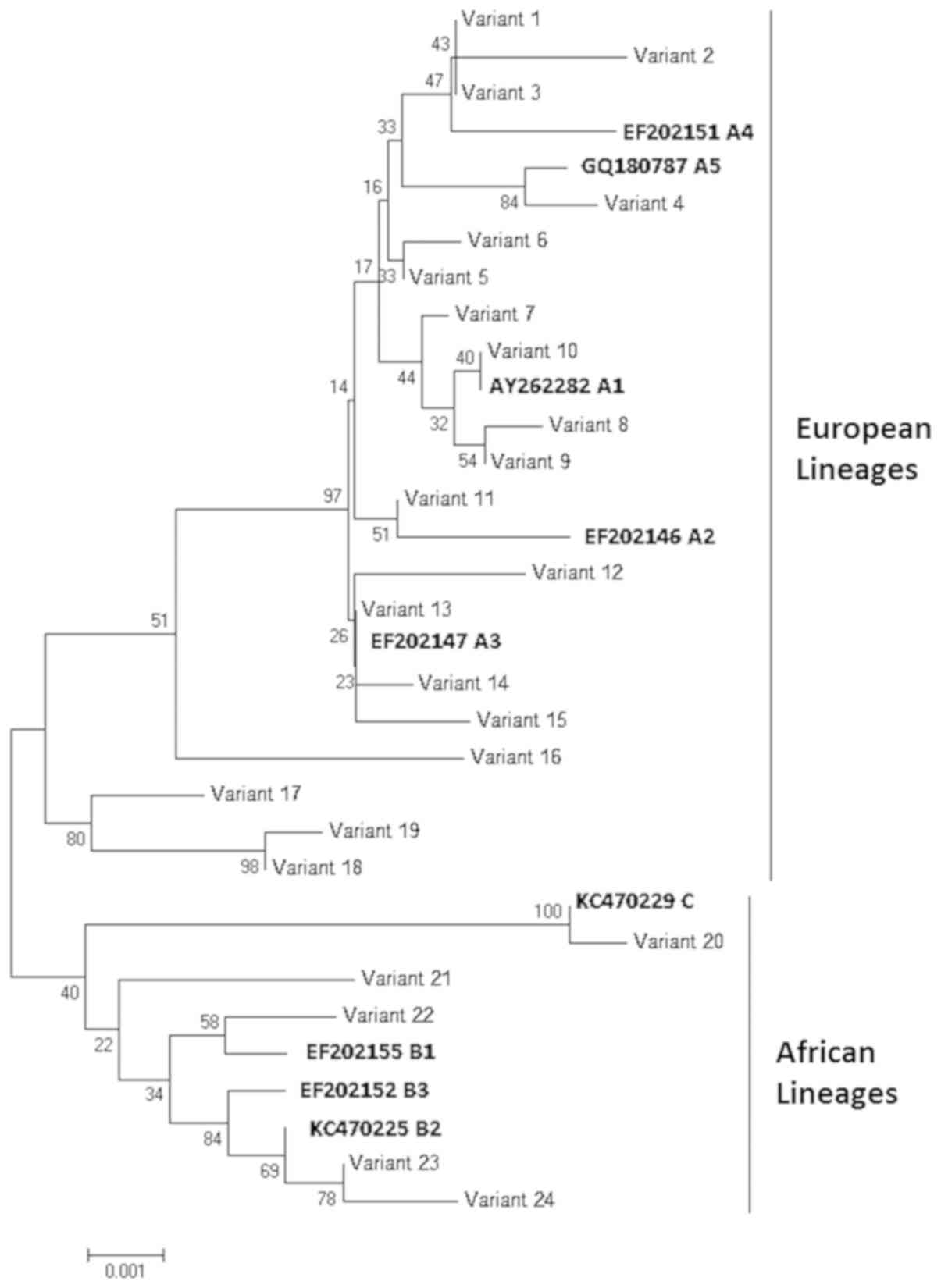|
1
|
Serrano B, Brotons M, Bosch FX and Bruni
L: Epidemiology and burden of HPV-related disease. Best Pract Res
Clin Obstet Gynaecol. 47:14–26. 2018. View Article : Google Scholar : PubMed/NCBI
|
|
2
|
De Martel C, Plummer M, Vignat J and
Franceschi S: Worldwide burden of cancer attributable to HPV by
site, country and HPV type. Int J Cancer. 141:664–670. 2017.
View Article : Google Scholar : PubMed/NCBI
|
|
3
|
Westrich JA, Warren CJ and Pyeon D:
Evasion of the host immune defences by human papillomavirus. Virus
Res. 231:21–33. 2017. View Article : Google Scholar : PubMed/NCBI
|
|
4
|
Burk RD, Harari A and Chen Z: Human
papillomavirus genome variants. Virology. 445:232–243. 2013.
View Article : Google Scholar : PubMed/NCBI
|
|
5
|
Smith B, Chen Z, Reimers L, van Doorslaer
K, Schiffman M, Desalle R, Herrero R, Yu K, Wacholder S, Wang T and
Burk RD: Sequence imputation of HPV16 genomes for genetic
association studies. PLoS One. 6:e213752011. View Article : Google Scholar : PubMed/NCBI
|
|
6
|
Mammas IN, Spandidos DA and Sourvinos G:
Genomic diversity of human papillomaviruses (HPV) and clinical
implications: An overview in adulthood and childhood. Infect Genet
Evol. 21:220–226. 2014. View Article : Google Scholar : PubMed/NCBI
|
|
7
|
Cornet I, Gheit T, Franceschi S, Vignat J,
Burk RD, Sylla BS, Tommasino M and Clifford GM; IARC HPV Variant
Study Group, : Human papillomavirus type 16 genetic variants:
Phylogeny and classification based on E6 and LCR. J Virol.
86:6855–6861. 2012. View Article : Google Scholar : PubMed/NCBI
|
|
8
|
Chen AA, Gheit T, Franceschi S, Tommasino
M and Clifford GM: Human papillomavirus 18 genetic variation and
cervical cancer risk worldwide. J Virol. 89:10680–10687. 2015.
View Article : Google Scholar : PubMed/NCBI
|
|
9
|
O'Connor M, Chan SY and Bernard HU:
Transcription factor binding sites in the long control region of
genital HPVs. Human papillomaviruses. A compilation and analysis of
nucleic acid and amino acid sequences Los Alamos, New Mexico: Los
Alamos National Laboratory; pp. III21–III41. 1995
|
|
10
|
Kirnbauer R, Booy F, Cheng N, Lowy DR and
Schiller JT: Papillomavirus L1 major capsid protein self-assembles
into virus-like particles that are highly immunogenic. Proc Natl
Acad Sci USA. 89:12180–12184. 1992. View Article : Google Scholar : PubMed/NCBI
|
|
11
|
Christensen ND, Dillner J, Eklund C,
Carter JJ, Wipf GC, Reed CA, Cladel NM and Galloway DA: Surface
conformational and linear epitopes on HPV-16 and HPV-18 L1
virus-like particles as defined by monoclonal antibodies. Virology.
223:174–184. 1996. View Article : Google Scholar : PubMed/NCBI
|
|
12
|
Martins AE, Lucena-Silva N, Garcia RG,
Welkovic S, Barboza A, Menezes ML, Maruza M, Tenorio T and Ximenes
RA: Prevalence of human papillomavirus infection, distribution of
viral types and risk factors in cervical samples from human
immunodeficiency virus-positive women attending three human
immunodeficiency virus-acquired immune deficiency syndrome
reference centres in northeastern Brazil. Mem Inst Oswaldo Cruz.
109:738–747. 2014. View Article : Google Scholar : PubMed/NCBI
|
|
13
|
Bianchi S, Boveri S, Igidbashian S,
Amendola A, Urbinati AM, Frati ER, Bottari F, Colzani D, Landoni F,
Tanzi E, et al: Chlamydia trachomatis infection and HPV/Chlamydia
trachomatis co-infection among HPV-vaccinated young women at the
beginning of their sexual activity. Arch Gynecol Obstet.
294:1227–1233. 2016. View Article : Google Scholar : PubMed/NCBI
|
|
14
|
Panatto D, Amicizia D, Bianchi S, Frati
ER, Zotti CM, Lai PL, Domnich A, Colzani D, Gasparini R and Tanzi
E: Chlamydia trachomatis prevalence and chlamydial/HPV co-infection
among HPV-unvaccinated young Italian females with normal cytology.
Hum Vaccin Immunother. 11:270–276. 2015. View Article : Google Scholar : PubMed/NCBI
|
|
15
|
Orlando G, Fasolo M, Mazza F, Ricci E,
Esposito S, Frati E, Zuccotti GV, Cetin I, Gramegna M, Rizzardini
G, et al: Risk of cervical HPV infection and prevalence of
vaccine-type and other high-risk HPV types among sexually active
teens and young women (13–26 years) enrolled in the VALHIDATE
study. Hum Vaccin Immunother. 10:986–994. 2014. View Article : Google Scholar : PubMed/NCBI
|
|
16
|
Orlando G, Tanzi E, Rizzardini G,
Chatenoud L, Zanchetta N, Esposito S, Tisi G, Fasolo M, Bosari S,
Boero V, et al: Modifiable and Non-modifiable factors related to
HPV infection and cervical abnormalities in women at high risk: A
cross-sectional analysis from the VALHIDATE Study. Ann Virol Res.
2:10132016.
|
|
17
|
Tanzi E, Amendola A, Bianchi S, Fasolo MM,
Beretta R, Pariani E, Zappa A, Frati E and Orlando G: Human
papillomavirus genotypes and phylogenetic analysis of HPV-16
variants in HIV-1 infected subjects in Italy. Vaccine. 27 (Suppl
1):A17–A23. 2009. View Article : Google Scholar : PubMed/NCBI
|
|
18
|
Zhang C, Park JS, Grce M, Hibbitts S,
Palefsky JM, Konno R, Smith-McCune KK, Giovannelli L, Chu TY,
Picconi MA, et al: Geographical distribution and risk association
of human papillomavirus genotype 52-variant lineages. J Infect Dis.
210:1600–1604. 2014. View Article : Google Scholar : PubMed/NCBI
|
|
19
|
Frati ER, Bianchi S, Colzani D, Zappa A,
Orlando G and Tanzi E: Genetic variability in the major capsid L1
protein of human papillomavirus type 16 (HPV-16) and 18 (HPV-18).
Infect Genet Evol. 11:2119–2124. 2011. View Article : Google Scholar : PubMed/NCBI
|
|
20
|
Larkin MA, Blackshields G, Brown NP,
Chenna R, McGettigan PA, McWilliam H, Valentin F, Wallace IM, Wilm
A, Lopez R, et al: Clustal W and Clustal X version 2.0.
Bioinformatics. 23:2947–2948. 2007. View Article : Google Scholar : PubMed/NCBI
|
|
21
|
Tamura K, Stecher G, Peterson D, Filipski
A and Kumar S: MEGA6: Molecular evolutionary genetics analysis
version 6.0. Mol Biol Evol. 30:2725–2729. 2013. View Article : Google Scholar : PubMed/NCBI
|
|
22
|
Hall TA: BioEdit: A user-friendly
biological sequence alignment editor and analysis program for
Windows 95/98/NT. Nucl Acids Symp. 41:95–98. 1999.
|
|
23
|
Saitou N and Nei M: The neighbor-joining
method: A new method for reconstructing phylogenetic trees. Mol
Biol Evol. 4:406–425. 1987.PubMed/NCBI
|
|
24
|
Kimura M: A simple method for estimating
evolutionary rate of base substitutions through comparative studies
of nucleotide sequences. J Mol Evol. 16:111–120. 1980. View Article : Google Scholar : PubMed/NCBI
|
|
25
|
Weaver S, Shank SD, Spielman SJ, Li M,
Muse SV and Kosakovsky Pond SL: Datamonkey 2.0: A modern web
application for characterizing selective and other evolutionary
processes. Mol Biol Evol. Jan 2–2018.doi: 10.1093/molbev/msx335
(Epub ahead of print). View Article : Google Scholar
|
|
26
|
Frati ER, Fasoli E, Martinelli M, Colzani
D, Bianchi S, Carnelli L, Amendola A, Olivani P and Tanzi E:
Sexually transmitted infections: A novel screening strategy for
improving women's health in vulnerable populations. Int J Mol Sci.
18:E13112017. View Article : Google Scholar : PubMed/NCBI
|
|
27
|
Marongiu L, Godi A, Parry JV and Beddows
S: Human papillomavirus type 16 long control region and E6 variants
stratified by cervical disease stage. Infect Genet Evol. 26:8–13.
2014. View Article : Google Scholar : PubMed/NCBI
|
|
28
|
Ning T, Wolfe A, Nie J, Huang W, Chen XS
and Wang Y: Naturally occurring single amino acid substitution in
the L1 major capsid protein of human papillomavirus type 16:
Alteration of susceptibility to antibody-mediated neutralization. J
Infect Dis. 216:867–876. 2017. View Article : Google Scholar : PubMed/NCBI
|
|
29
|
Van der Weele P, Meijer CJLM and King AJ:
Whole-genome sequencing and variant analysis of human
papillomavirus 16 infections. J Virol. 91(pii): e00844–17.
2017.PubMed/NCBI
|

















